
Sir (George) Gilbert Scott, knighted as Sir Gilbert Scott, was a prolific English Gothic revival architect, chiefly associated with the design, building and renovation of churches and cathedrals, although he started his career as a leading designer of workhouses. Over 800 buildings were designed or altered by him.

Worksop is a market town in Nottinghamshire in the East Midlands of England and the administrative centre of the Bassetlaw district. It is located 19 miles (31 km) east-south-east of Sheffield, close to Nottinghamshire's borders with South Yorkshire and Derbyshire, on the River Ryton and not far from the northern edge of Sherwood Forest. It is known as the "Gateway to The Dukeries", because of its proximity to former Ducal estates such as Clumber House, Thoresby Hall, Welbeck Abbey and Worksop Manor, as well as estates such as Rufford Abbey and Hodsock Priory.

Arnold is a market town and unparished area in the Borough of Gedling in the ceremonial county of Nottinghamshire in the East Midlands of England. It is situated to the north-east of Nottingham's city boundary. Arnold has the largest town centre in the Borough of Gedling and the most important town centre in the northeastern part of the conurbation of Greater Nottingham. Gedling Borough Council is headquartered in Arnold. Since 1968 Arnold has had a market, and the town used to have numerous factories associated with the hosiery industry. Nottinghamshire Police have been headquartered in Arnold since 1979. At the time of the 2011 United Kingdom census, Arnold had a population of 37,768.

George Frederick Bodley was an English Gothic Revival architect. He was a pupil of Sir George Gilbert Scott, and worked in partnership with Thomas Garner for much of his career. He was one of the founders of Watts & Co.

Bingham is a market town in the Rushcliffe borough of Nottinghamshire, England, 9 miles (14 km) east of Nottingham, 11.7 miles south-west of Newark-on-Trent and 14.5 miles west of Grantham. The town had a population of 9,131 at the 2011 census.

Sutton-in-Ashfield is a market town in Nottinghamshire, England, with a population of 48,527 in 2019. It is the largest town in the district of Ashfield, four miles west of Mansfield, two miles from the Derbyshire border and 12 miles north of Nottingham.

Southwell is a town in the district of Newark and Sherwood in Nottinghamshire, England. It includes Southwell Minster, the cathedral of the Anglican Diocese of Southwell and Nottingham. A population of under 7,000 rose to 7,297 at the 2011 Census, and was put at 6,853 in 2019. The origin of the name is unclear. It lies on the River Greet, about 14 miles north-east of Nottingham. Other historic buildings include prebendal houses in Church Street and Westgate and the Methodist church, which has a right of way beneath it, so that the upper floor seats more than the lower. The workhouse (1824) was a prototype for many others. Owned by the National Trust, it shows its appearance in the 19th century. Behind the Minster is a partly ruined palace, once a residence of the Archbishop of York. It includes the recently restored State Chamber, Cardinal Wolsey's former dining room, and gardens among the ruins.

Charles Eamer Kempe was a Victorian era designer and manufacturer of stained glass. His studios produced over 4,000 windows and also designs for altars and altar frontals, furniture and furnishings, lichgates and memorials that helped to define a later nineteenth-century Anglican style. The list of English cathedrals containing examples of his work includes: Chester, Gloucester, Hereford, Lichfield, Wells, Winchester and York. Kempe's networks of patrons and influence stretched from the Royal Family and the Church of England hierarchy to the literary and artistic beau monde.

Flintham is an English village and civil parish in Nottinghamshire, some seven miles from Newark-on-Trent, opposite RAF Syerston on the A46. Its population was 597 at the 2011 Census and estimated at 586 in 2019. The village name was taken by the Ham class minesweeper HMS Flintham.

St Peter's Church, formally The Church of St Peter with St James, is an Anglican parish church in the city centre of Nottingham, England. It is part of the parish of All Saints', St Mary's and St Peter's, Nottingham.

Thomas Chambers Hine was an architect based in Nottingham.
Henry Isaac Stevens FRIBA was an architect based in Derby. He was born in London, in 1806, and died in 1873. In the late 1850s he changed his name to Isaac Henry Stevens.

St. Mary's Church, Attenborough is a parish church in the Church of England in the village of Attenborough, Nottinghamshire.

All Saints' Church, Rempstone is a parish church in the Church of England in Rempstone, Nottinghamshire.

Charles Hodgson Fowler was a prolific English ecclesiastical architect who specialised in building and, especially, restoring churches.

The Church of St Mary the Virgin is the oldest religious foundation in the City of Nottingham, England, the largest church after the Roman Catholic Cathedral in Nottingham and the largest mediaeval building in the city.

James Fowler, known as 'Fowler of Louth', is best known as a Victorian English church architect and associated with the restoration and renovation of churches. However, he was also the architect of a wide variety of other buildings. A listing of his work compiled in 1991 traced over 210 buildings that he designed or restored. He is known to be the architect for 24 new churches and his work also included 40 vicarages or rectories, 13 schools, four almshouses, a Savings Bank, a convalescent home and hospital as well as country houses and estate housing. Most of Fowler’s work was in Lincolnshire and particularly around Louth, but he also worked in the East Riding of Yorkshire, Nottinghamshire, Staffordshire, Suffolk, London, Sussex and Devon.

Richard Roe, also Rowe, of Epperstone was one of the earliest clockmakers in Nottinghamshire.














































